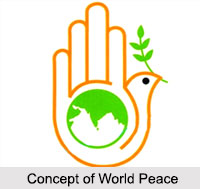 Jain principles of Ahimsa (Non-violence), Aparigraha (Non-possession) and Anekanta (Non-absolutism), the three A"s, help to analyze and suggest how peaceful co-existence is possible in the world. Peace, which is desperate imperative, at individual level or national level, can be achieved, when these principles are followed. Peace is the aspect, which cannot be brought about from outside, it is the internal state of mind. With the feelings, one can change the environment around.
Jain principles of Ahimsa (Non-violence), Aparigraha (Non-possession) and Anekanta (Non-absolutism), the three A"s, help to analyze and suggest how peaceful co-existence is possible in the world. Peace, which is desperate imperative, at individual level or national level, can be achieved, when these principles are followed. Peace is the aspect, which cannot be brought about from outside, it is the internal state of mind. With the feelings, one can change the environment around.
Ahimsa for World Peace
The principle of non-violence, which is propounded by Jain tradition, can be applied to all spheres of life. The social aspect includes all the living beings and helps to get the fruits of non-violence to all living beings. When the person understands the principle of non-violence and applies it in every activity, speech and thought, then the very root cause of unrest and unhappiness will end and world will be better to place to live. Mahatma Gandhi was greatly influenced by Jain principles on non-violence.
Aparigraha for World Peace
The principle of non-possession, or in other words limiting one"s possessions, is very much related to non-violence. The attachment to possession of land, commodities, livestock, etc. becomes the cause of violence. Desires are limitless and it is human nature to acquire more and more, one is not satisfied with what he/ she has. This lust and greed to possess lead to the state of war and unrest. If one follows the principle of Aparigraha, it will not only be beneficial to oneself but to society at large.
Anekantavada for World Peace
The principle of non-violence when extended towards every object, place, person or thing considering that reality can have exactly opposing aspects in the same object; one gets the theory of Anekantavada.This beautiful concept of "Anekantavada", the doctrine of relativity of judgments, says that Reality is multifaceted. In order to realize the true nature of reality, one must see it from all different perspectives. When reality is seen from one perspective, it does not reveal its true nature. One must see it from different perspectives and later on transcend all the different perspectives to actually realize it.
One forms the judgments based on the understanding that one has. The time and space also play an important role in formation of those judgments. Nobody is free from limitations. Thus the person"s perception of reality is just one aspect of it. But reality has many dimensions. One must try to look at the reality from all the different aspects. This is practice of non-violence in thoughts.
Man"s relationship to Man for the World Peace
When the mental violence is converted to physical violence, it not only harms the self but also others. Selfish activities, jealousy, greed and lack of consideration for others may give one pleasure but ultimately cause misery. If humans can expand their circle and include every other human being in it with compassion, the world will definitely be a good place to live in. When each one behaves in right manner, there will be peace in the world.
Today this principle is followed by "Anuvrata Movement", which is meant for common man. Five small Anuvratas can bring about big changes in the world. When each one can get engaged in the well being of the other, the world can be a better place to live. It is the responsibility of each and every individual to work for the world peace.




















